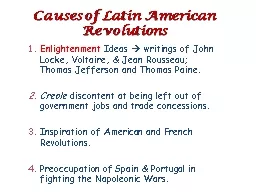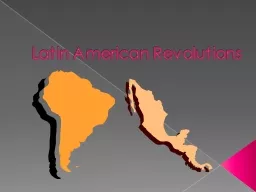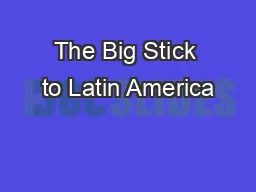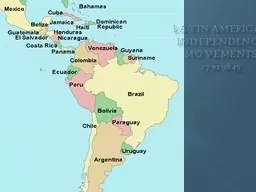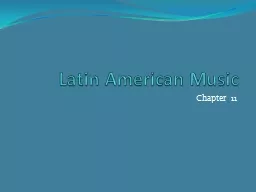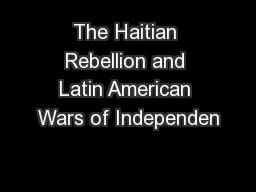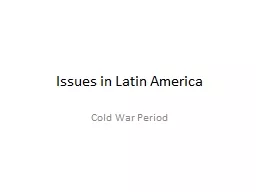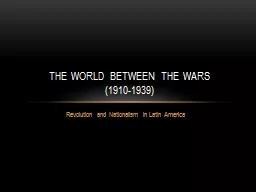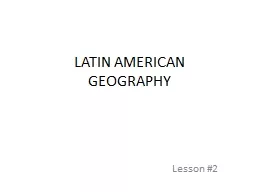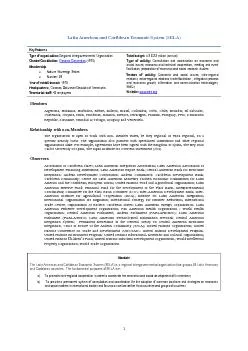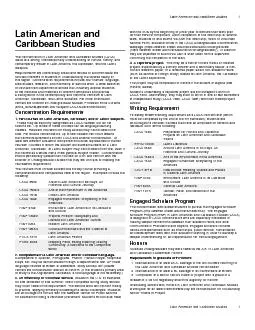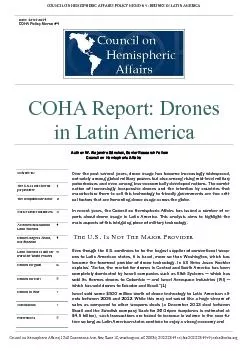PPT-Causes of Latin American
Author : calandra-battersby | Published Date : 2018-10-26
Revolutions Enlightenment Ideas writings of John Locke Voltaire amp Jean Rousseau Thomas Jefferson and Thomas Paine Creole discontent at being left out of government
Presentation Embed Code
Download Presentation
Download Presentation The PPT/PDF document "Causes of Latin American" is the property of its rightful owner. Permission is granted to download and print the materials on this website for personal, non-commercial use only, and to display it on your personal computer provided you do not modify the materials and that you retain all copyright notices contained in the materials. By downloading content from our website, you accept the terms of this agreement.
Causes of Latin American: Transcript
Revolutions Enlightenment Ideas writings of John Locke Voltaire amp Jean Rousseau Thomas Jefferson and Thomas Paine Creole discontent at being left out of government jobs and trade concessions. Imperialist powers controlled Latin America with economic influence and political intervention. . Economic Imperialism. Economic Imperialism. By the end of the 1800s, the U.S. and Europe were buying many products from Latin America.. Create a tree map with 3 branches!. Title is “Revolutions in the Americas”. Branch #1 is “Haitian Revolution”. Branch #2 is “Mexican Revolution”. Branch #3 is “South American Revolution”. Chapter 22, Section 4. By the late 1800’s the United States had built an empire that stretched from the Atlantic to the Pacific Ocean. The nation needed a shorter, quicker route between the two oceans. 1791-1845. Independence Movements in Latin America. European domination of Latin . America. Spread . of Enlightenment . ideas. American . and French . revolutions. Growth . of nationalism in Latin America. Chapter 11. Latin America/Latin Music. Here, “Latin Music” = Latin American Music. Latin America = “large and culturally diverse region of the world encompassing all of South America and the various nations and territories of Central America, Mexico, and the Caribbean” . Toussaint L’Overture and El Libertador . Background to A Rebellion. One of the key moments in the spread of the Atlantic revolutions to Latin America and the Caribbean was the Haitian Rebellion (1791-1804). Cold War Period. TODAY’s OBJECTIVES:. Explain the political context in Latin America after WWII . Explain . how the Cold War affected . Latin America. Following . WWII – the political grouping into three “worlds”:. The World Between the Wars . (1910-1939). Mexican Revolution. By 1910, the dictator . Profirio. Diaz. had ruled Mexico for almost 35 years, winning re-election as president again and again. On the surface, Mexico enjoyed peace and economic growth. Diaz welcomed foreign investors who developed mines, built railroads, and drilled for oil.. Lesson #2. Earthquake Zones. Active Volcanoes. Physical Features. . Dense __________________ mixed with mountainous terrain and dry, arid lands. . Tropical Islands (Caribbean) . RAIN FOREST. Physical Features. Presented at the . Latin American Biologics/Biosimilars Conference. Sao Paulo, Brazil. September 27, 2016. Harry L. Gewanter, MD, FAAP, FACR . Chairman, Alliance for Safe Biologic Medicines (ASBM). 1 nd Caribbean Economic System (SELA) Key features Type of organisation: Regional Intergovernmental Organi s ation Charter/Constitution: Panama Convention (1975) Membership Nature: Sovereign State L Latin American and Caribbean Studies The concentration in Latin American and Caribbean Studies (LACA) leads to a strong, interdisciplinary understanding of culture, history, and contemporary issues Council on Hemispheric Affairsȁ 1250 Connecticut Ave, NW, Suite 1C, Washington, DC 20036ȁ 202.223.4975ȁ fax:202.223.4979ȁ coh a@c oha.org COHA Report: Drones in Latin America Over the past severa CONTENTSPage1 Background 12 Approach 2a Provision of teaching books 2b Role of the PAHO Regional Library of Medicineand the Health Sciences 2c Visual aids 3d Training of pathologists in Latin America
Download Document
Here is the link to download the presentation.
"Causes of Latin American"The content belongs to its owner. You may download and print it for personal use, without modification, and keep all copyright notices. By downloading, you agree to these terms.
Related Documents

